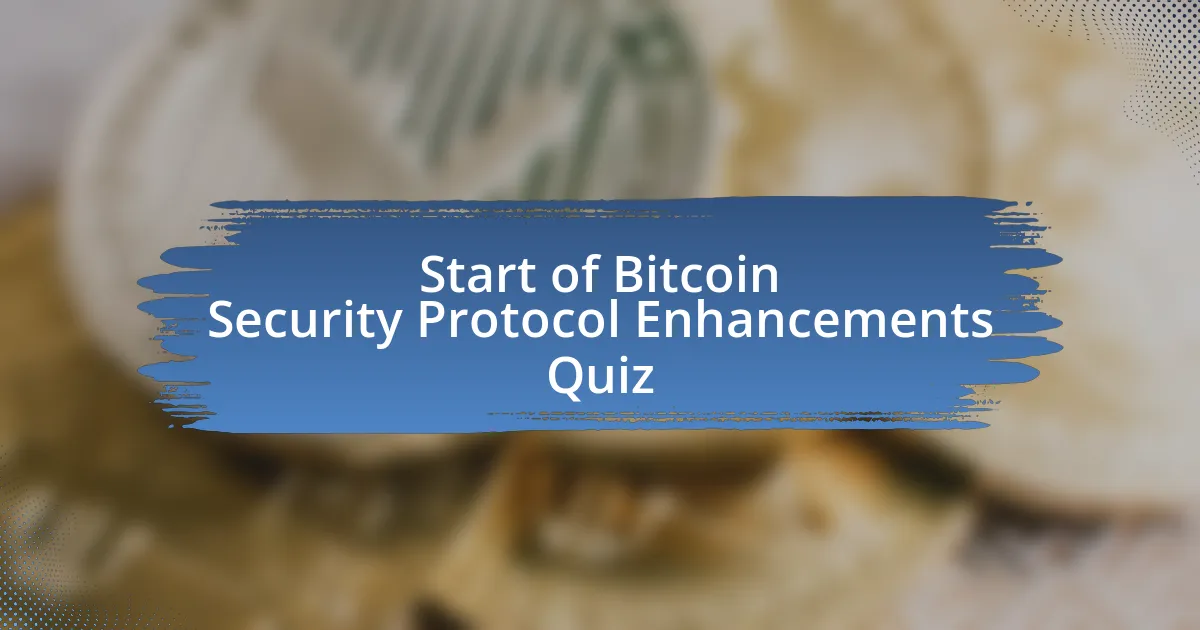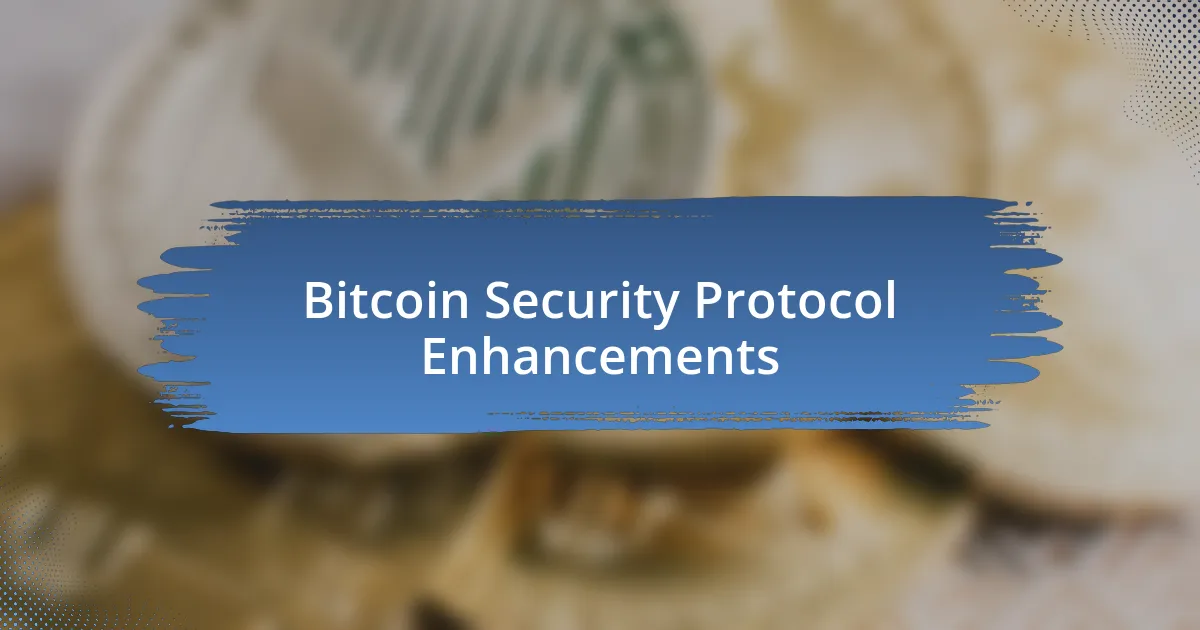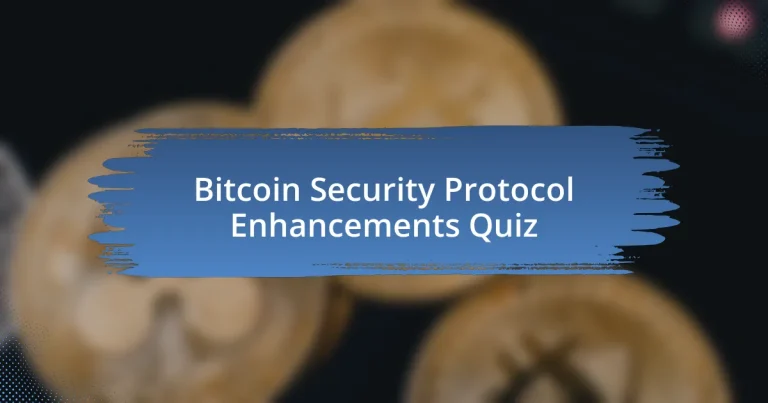
Start of Bitcoin Security Protocol Enhancements Quiz
1. What security enhancement does Schnorr signatures provide to Bitcoin transactions?
- Increased transaction fees and times.
- Enhanced privacy and efficiency.
- Reduced security and anonymity.
- Simplified transaction processes.
2. How does Taproot facilitate the creation of more complex smart contracts in Bitcoin?
- It simplifies Bitcoin`s existing scripting language for all users.
- It reduces block sizes for faster transaction processing.
- By using Tapscript, Taproot allows the implementation of more intricate spending conditions.
- It removes the need for miners in transaction validation.
3. In what way does SegWit improve Bitcoin`s overall network capacity?
- To reduce transaction size and increase scalability.
- To make Bitcoin transactions anonymous.
- To lower transaction fees permanently.
- To enhance security and prevent hacking.
4. How does the integration of Schnorr signatures in Taproot affect transaction privacy?
- It enhances transaction anonymity by obscuring transaction details.
- It increases the transaction limit to 10,000.
- It eliminates the need for miners in Bitcoin.
- It reduces transaction fees by half.
5. What functionalities does Tapscript introduce to the Bitcoin scripting process?
- It creates a completely new blockchain.
- It allows unlimited transaction sizes.
- It improves efficiency and flexibility in scripts.
- It eliminates the need for transaction fees.
6. Why are blocks considered a limitation in Bitcoin`s transaction speed?
- Blocks can hold unlimited transactions, speeding up the network.
- Blocks have a finite size and are processed by miners every 10 minutes.
- Blocks are encrypted, which slows down transactions.
- Blocks are only added once a week, causing delays.
7. What unique benefit does the Lightning Network offer to Bitcoin users?
- It provides an off-chain scaling solution to mitigate fees and long transaction times.
- It eliminates the need for mining to validate transactions.
- It increases the block size limit to enhance transaction speed.
- It guarantees instant confirmations for all transactions on the main chain.
8. What fundamental technology supports the entire Bitcoin network?
- Blockchain
- Artificial Intelligence
- Cloud computing
- Internet of Things
9. Can Bitcoin transactions be sent to different blockchain networks?
- Yes
- No
- Sometimes
- Only with special tools
10. What interval determines the discovery of new Bitcoin blocks?
- Every 10 minutes
- Every 5 minutes
- Every hour
- Every 15 minutes
11. Why is SHA-256 critical to Bitcoin`s security protocols?
- It enhances transaction speed to facilitate quick exchanges.
- It secures transactions through cryptographic hashing techniques.
- It allows for anonymous usage without any blockchain trace.
- It reduces the overall transaction fees to improve accessibility.
12. What role does a nonce play in the Bitcoin mining process?
- The hash rate of a mining rig.
- A type of transaction fee miners receive.
- A number that miners adjust to find a valid block hash.
- A security feature to protect the blockchain.
13. How significant is Bitcoin`s energy consumption in terms of global energy use?
- Bitcoin accounts for 10 percent of global energy use.
- Bitcoin consumes roughly 1 percent of the world’s energy consumption.
- Bitcoin energy consumption is less than 0.1 percent of global energy.
- Bitcoin produces more energy than it consumes globally.
14. What does Bitcoin`s energy consumption imply about its defense against attacks?
- It suggests that high energy use reduces the validity of transactions.
- It implies that energy consumption leads to faster transaction speeds.
- It means that lower energy consumption makes Bitcoin more susceptible to attacks.
- It makes the network secure to the point that it would require approximately 1% of the entire world’s energy consumption to attack the network.
15. How does the Merkle Root contribute to transaction verification in Bitcoin?
- A hash of all transactions in a block that allows any specific transaction to be verified without downloading the entire blockchain.
- A method for encrypting transaction data before it is sent.
- A list of all users that can send transactions on the network.
- A tool used to create new blocks in the blockchain.
16. What is the function of zero-knowledge proofs in promoting Bitcoin privacy?
- To create a decentralized voting system.
- To enhance security and privacy by proving the truth of a statement without revealing any information.
- To allow unlimited transaction sizes on the network.
- To increase Bitcoin`s mining rewards significantly.
17. How do ZKPs facilitate confidential transaction confirmations within Bitcoin?
- By storing all transaction details on a public ledger for verification.
- By requiring multiple confirmations from different miners for each transaction.
- By encrypting the entire transaction data before submission.
- By allowing transaction validations without revealing all transaction information.
18. Which blockchain employs zero-knowledge proofs to maintain confidentiality?
- Hyperledger
- Bitcoin
- Ethereum
- zkLedger
19. How does LayerEdge enhance the efficiency of Bitcoin`s verification process?
- It enhances the mining hardware to process transactions quicker.
- It utilizes additional miners to increase transaction throughput.
- It aggregates zero-knowledge proofs to reduce verification costs on the Bitcoin network by 90%.
- It implements a new consensus algorithm for faster block validation.
20. What added security feature do multi-signature wallets provide for Bitcoin users?
- Instant transaction confirmation
- Unlimited transaction size
- Additional approvals required
- Simplified access management
21. In what way do multi-signature wallets mitigate the risk of account breaches?
- By storing all funds in a single wallet.
- By requiring multiple approvals from different users.
- By eliminating the need for passwords entirely.
- By making transactions completely anonymous.
22. What potential risk does quantum computing impose on Bitcoin`s security model?
- The possibility of quantum computers deciphering Bitcoin`s cryptographic keys, leading to unauthorized access to wallets.
- Quantum computers enhancing transaction speeds significantly.
- Quantum computers eliminating mining requirements entirely.
- Quantum computers storing Bitcoin more efficiently.
23. How is the Bitcoin network proactively addressing threats from quantum computing?
- By using existing encryption methods without changes.
- By increasing the block size to enhance security.
- By limiting the number of transactions processed.
- By researching and developing quantum-resistant cryptographic algorithms.
24. What do post-quantum cryptographic solutions aim to achieve?
- Increasing the length of encryption keys indefinitely.
- Ensuring only classical computers can access encrypted data.
- Developing new types of hardware for faster computations.
- Creating algorithms that even quantum computers would find difficult to crack.
25. How does an open-source model reinforce Bitcoin`s security measures?
- Through peer review and community vigilance in addressing vulnerabilities.
- By limiting the number of transactions processed.
- By reducing mining rewards for participants.
- By storing all data on centralized servers.
26. What change in user behavior reflects a heightened awareness of Bitcoin security?
- Users frequently ignore security protocols.
- Users no longer use hardware wallets.
- Users are more cautious about their private keys.
- Users are less concerned about transaction fees.
27. What motivates individuals to engage in Bitcoin block mining activities?
- Social media promotions drive engagement in Bitcoin mining.
- Public blockchains offer rewards for mining in the form of cryptocurrency.
- Mining tools are provided for free to all participants.
- Individuals are motivated by volunteering for community service.
28. What is the ideal blockchain structure for an organization seeking minimal security maintenance?
- A private blockchain
- A hybrid blockchain
- A consortium blockchain
- A public blockchain
29. What distinguishes the Hyperledger network from public blockchain networks?
- It allows unlimited transactions without restrictions.
- It is a public blockchain network.
- It is fully decentralized without any permissions.
- It is a private blockchain network.
30. Which protocol upgrade reduces data size in Bitcoin transactions to improve scalability?
- Lightning
- SegWit
- Tapscript
- Schnorr

Congratulations! You’ve Successfully Completed the Quiz
Thank you for participating in our quiz on Bitcoin Security Protocol Enhancements. We hope you found the questions engaging and informative. Through this experience, you likely gained a better understanding of how security protocols protect Bitcoin transactions and how these advancements enhance overall network integrity.
Quizzes can be fun and educational. They often reveal gaps in knowledge and encourage further exploration. Perhaps you learned about new encryption techniques or the importance of multi-signature wallets. Each insight is a step toward becoming more proficient in the ever-evolving world of cryptocurrency.
We invite you to deepen your knowledge by checking the next section on this page. There, you’ll find detailed information on Bitcoin Security Protocol Enhancements that can offer you further clarity and insight. Expanding your understanding of these concepts is essential, as it empowers you to make informed decisions in the crypto space.

Bitcoin Security Protocol Enhancements
Overview of Bitcoin Security Protocols
Bitcoin security protocols are measures designed to protect the integrity and functionality of the Bitcoin network. These protocols encompass cryptographic techniques that safeguard transactions and ensure that users have control over their funds. The decentralized nature of Bitcoin relies on these protocols to prevent fraud, double spending, and unauthorized access. Well-known protocols include the use of public key cryptography and the blockchain’s consensus mechanism, which collectively provide a secure environment for peer-to-peer transactions.
Importance of Enhanced Security Protocols
Enhanced security protocols are crucial for maintaining trust in the Bitcoin ecosystem. As the value of Bitcoin increases, so does the incentive for malicious attacks. Improvements in security protocols help to mitigate risks such as hacking, theft, and phishing. By continuously enhancing security measures, the Bitcoin community can protect users and maintain the credibility of the currency. Enhanced protocols also attract more users and businesses, contributing to the overall growth of the ecosystem.
Two-Factor Authentication in Bitcoin Security
Two-factor authentication (2FA) provides an additional layer of security for Bitcoin wallets and exchanges. It requires users to verify their identity using two separate methods before accessing their accounts. Typically, this involves something the user knows, such as a password, and something the user has, like a smartphone app that generates a time-based one-time password. Implementing 2FA significantly reduces the risk of unauthorized access, making it more difficult for attackers to compromise accounts.
Multi-Signature Wallets for Enhanced Security
Multi-signature wallets require multiple private keys to authorize a Bitcoin transaction. This feature increases security by ensuring that no single entity has complete control over the funds. Transactions can only be initiated when a predefined number of signatures is received, which makes fraudulent activities more challenging. Multi-signature wallets are particularly beneficial for organizations or groups managing shared funds, as they provide additional oversight and security against theft.
Future Developments in Bitcoin Security Protocols
Future developments in Bitcoin security protocols focus on enhancing scalability and resilience against evolving threats. Innovations such as Schnorr signatures and Taproot aim to improve transaction privacy and efficiency. Furthermore, advancements in quantum-resistant cryptography are being explored to prepare for potential future vulnerabilities. These ongoing improvements are essential for sustaining the long-term viability and security of the Bitcoin network as technology and attack strategies evolve.
What are Bitcoin security protocol enhancements?
Bitcoin security protocol enhancements refer to improvements made to the underlying technology and processes that protect Bitcoin transactions and user data. These enhancements include multi-signature wallets, which require multiple keys to authorize a transaction, and the use of Schnorr signatures, which improve privacy and reduce block size. The implementation of the Lightning Network also enhances security by enabling off-chain transactions, reducing the risk of on-chain attacks.
How do Bitcoin security protocol enhancements improve transaction safety?
Bitcoin security protocol enhancements improve transaction safety by reducing vulnerabilities and increasing transaction validation mechanisms. For example, the adoption of Segregated Witness (SegWit) separates transaction signatures from transaction data, minimizing the risk of transaction malleability. Additionally, the use of cryptographic techniques like hash functions ensures that transaction data remains tamper-proof, making unauthorized alteration virtually impossible.
Where are these Bitcoin security protocol enhancements applied?
Bitcoin security protocol enhancements are applied in various areas of the Bitcoin network. They are integrated into Bitcoin Core, the primary software for Bitcoin nodes. Wallets, exchanges, and payment processors also implement these enhancements to provide a high level of security to their users. For instance, many wallets now support multi-signature transactions to enhance user security.
When were significant Bitcoin security protocol enhancements implemented?
Significant Bitcoin security protocol enhancements have been implemented gradually, with notable upgrades occurring in recent years. For example, Segregated Witness was activated in August 2017. The first proposals for multi-signature wallets began to emerge around 2012, with increasing adoption seen in subsequent years. Each of these enhancements reflects ongoing efforts to improve Bitcoin’s security and usability.
Who is responsible for Bitcoin security protocol enhancements?
Bitcoin security protocol enhancements are primarily driven by Bitcoin Core developers and the broader cryptocurrency developer community. These individuals and teams propose, code, and test improvements through a collaborative process. Additionally, input from users, miners, and exchanges influences the development and implementation of these security protocols, ensuring that enhancements meet the community’s needs.


